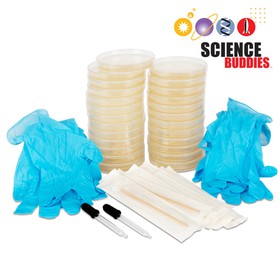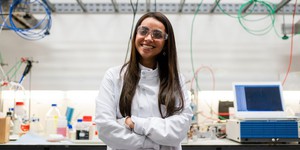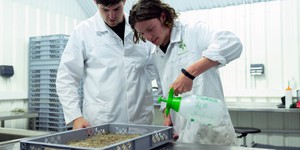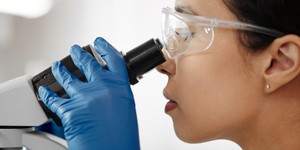Abstract
Have you ever noticed that most yogurt containers say they contain "live cultures"? What does that mean? The label is suggesting that the yogurt has living bacteria in it! While some types of bacteria can make you sick, some are actually important to keep you healthy. But individual bacteria are so tiny that you cannot see one with the naked eye, so how can you tell if bacteria are really living in your yogurt? In this science fair project, you will investigate whether yogurt actually contains live bacteria cultures by trying to grow bacteria from yogurt.Summary
- Play-Doh® is a registered trademark of Hasbro.
- Pyrex® is a registered trademark of Corning Incorporated.
- Anchor® is a registered trademark of The Anchor Hocking Company.
- Libbey® is a registered trademark of Libbey Glass Inc.
Recommended Project Supplies
Objective
To determine whether yogurt contains live cultures of bacteria.Introduction
A lot of dairy products, like yogurt, contain what their packaging calls "live cultures" or "live and active cultures." The live cultures these labels mention are cultures of bacteria. Bacteria are microorganisms, or in other words, microscopic organisms. Microscopic things are really tiny — you cannot usually see them with your naked eye. Figure 1 shows some bacteria as seen through a powerful microscope — these bacteria have been magnified about 8,000 times.
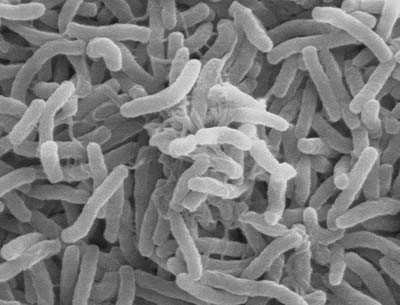 Image Credit: Wikimedia Commons / Public domain
Image Credit: Wikimedia Commons / Public domain
Figure 1. This image shows some bacteria that have been magnified using a powerful microscope.
When you hear the word "bacteria," you may think of people being sick. And even though some harmful types of bacteria make people sick, other types not only help people stay healthy, they need these bacteria to live! In fact, your body has more bacteria cells than human cells — biologists estimate that for every human cell in the body, there are 10 bacteria cells.
Because we need certain types of bacteria to be healthy, food producers often add these types of bacteria to yogurt and other dairy products. These are the live cultures. If you look at the ingredients listed on these products' packaging, you can usually identify the exact type, or species, of bacteria that is in the yogurt. Some species you might find listed are S. thermophilus, L. bulgaricus, L. acidophilus, Bifidus, and L. casei. These names are abbreviations of the genus and species name of the bacteria, where the first letter, such as "S." or "L.," represents the genus name, like "Streptococcus" and "Lactobacillus," and the next word is the species name. Table 1 lists several common bacteria names you may see listed on a yogurt product's packaging, along with the genus and species name of the bacteria.
| Yogurt Bacteria Species You Might Find Listed | Genus & Species Name of the Bacteria |
|---|---|
| "S. thermophilus" | Streptococcus thermophilus |
| "L. bulgaricus" | Lactobacillus bulgaricus |
| "L. acidophilus" | Lactobacillus acidophilus |
| "L. casei" | Lactobacillus casei |
| "L. rhamnosus" | Lactobacillus rhamnosus |
| "Bifidus" | Bifidobacterium animalis |
| "B. bifidum" | Bifidobacterium bifidum |
So how do you know if bacteria are in the yogurt? And how do you know if they are even alive, or if they died somehow? When you open a fresh container of yogurt, it probably does not look like much is living in it. You certainly should not see anything moving around! This is because an individual bacteria cell is microscopic (too small to see without a microscope).
One way you can investigate whether the yogurt contains living bacteria is by trying to grow more bacteria. Many different types of bacteria can grow on agar plates, which are special plastic dishes called petri dishes that have food for the bacteria to eat and a surface for them to grow on. As a bacteria cell eats and grows, it multiplies. The multiplying cells form a colony of bacteria, or a small cluster, that looks like a small spot on the agar plate. And you can see these bacteria colonies with your naked eye!
In this food science project, you will investigate whether living bacteria really exist in yogurt with labels that claim it contains "live cultures." You will try to grow bacteria from yogurt by putting a small amount of yogurt onto agar plates. You will then put the plates into a small chamber that has no oxygen — an anaerobic chamber that you will make from a bowl, a candle, and some Play-Doh®. Anaerobic means that there is no oxygen. Why would the bacteria grow where there is no oxygen? In your intestines, there is very little oxygen, and this is where the same types of bacteria that are added to yogurt naturally live. After the plates have been in your anaerobic chamber for several days, you should be able to see whether the yogurt contains living bacteria.
Terms and Concepts
- Live cultures
- Bacteria
- Microorganisms
- Microscopic
- Cells
- Species
- Agar plates
- Bacteria colonies
- Anaerobic chamber
- Anaerobic
- Sterilize
Questions
- How can you tell if bacteria are living somewhere?
- What is a bacteria colony?
- Why should bacteria from yogurt be grown in anaerobic conditions?
- What are some species of bacteria that you have seen listed on yogurt containers?
Bibliography
You can do further research by visiting the following websites, which give information about bacteria:
- Rader, A. (n.d.). Bacteria basics - They are alive! Biology4Kids.com.. Retrieved August 24, 2012.
- The Nemours Center for Children's Health Media. (2011, April). What are germs? KidsHealth. Retrieved August 24, 2012.
- National Yogurt Association. (n.d.). Live and active culture (LAC) yogurt FAQs. AboutYogurt.com. Retrieved August 24, 2012.
- neoK12TM (n.d.). Different types of bacteria. Retrieved August 24, 2012.
This science project was inspired by this laboratory experiment:
- Thiel, T. (1999). Cultivation of bacteria from commercial yogurt. Department of Biology, University of Missouri, St. Louis. Retrieved August 24, 2012.
Materials and Equipment 
Recommended Project Supplies
- Bacteria Discovery Kit, available from our partner
Home Science Tools. Needed from the kit:
- Nutrient agar plates (12)
- Sterile swabs (12)
- Disposable gloves (4 pairs)
- Medicine droppers (2)
- You will also need to gather these items, not included in the kit:
- Pot or saucepan
- Stove
- Paper towel or clean dishtowel
- Permanent marker
- Large Pyrex® bowl. Must be large enough to fit over three stacked agar plates and a tea light candle. Other fireproof, clear glass bowl brands (such as Libbey® or Anchor®) could be used instead.
- Stiff cutting board. If you are using a wooden cutting board, you will also need a piece of plastic wrap (large enough to cover the cutting board) and tape.
- 70% isopropyl rubbing alcohol; available at a grocery store or pharmacy
- Yogurt (3 containers; any size). Must fulfill the following requirements:
- Fresh, previously unopened containers.
- Look for a brand that advertises that it contains "live and active cultures" or that lists multiple bacteria species on its packaging, as discussed in the Introduction section and in Table 1 there.
- Do not use yogurt that has been heat treated, as this is a process that can destroy live cultures. To make sure the yogurt has not been heat treated, look for a seal that says the product contains "live and active cultures."
- New unopened bottle of distilled water; available at a grocery store or pharmacy
- Play-Doh® (18-oz.)
- Tea light candle
- Matches or lighter
- A warm room; ideally, it stays between 22 to 27 degrees Celsius, or about 72 to 80 degrees Fahrenheit
- Optional: Camera and black background, such as a sheet of black construction paper
- An adult helper
- Lab notebook
Disclaimer: Science Buddies participates in affiliate programs with Home Science Tools, Amazon.com, Carolina Biological, and Jameco Electronics. Proceeds from the affiliate programs help support Science Buddies, a 501(c)(3) public charity, and keep our resources free for everyone. Our top priority is student learning. If you have any comments (positive or negative) related to purchases you've made for science projects from recommendations on our site, please let us know. Write to us at scibuddy@sciencebuddies.org.
Experimental Procedure
For health and safety reasons, science fairs regulate what kinds of biological materials can be used in science fair projects. You should check with your science fair's Scientific Review Committee before starting this experiment to make sure your science fair project complies with all local rules. Many science fairs follow Regeneron International Science and Engineering Fair (ISEF) regulations. For more information, visit these Science Buddies pages: Project Involving Potentially Hazardous Biological Agents and Scientific Review Committee. You can also visit the webpage ISEF Rules & Guidelines directly.
Bacteria are everywhere. They live within the human gut, all around us in the air, on surfaces around our homes and outdoors, and basically in every corner of our environment. We come in contact with bacteria on a daily basis. So to make sure your science project shows whether live bacteria are in the yogurt, you need to avoid growing bacteria from other places. Many of the steps are about how to be extra careful and clean, so you do not end up growing these other bacteria.
Culturing Yogurt Bacteria in an Anaerobic Chamber
- Make sure the Pyrex® bowl, cutting board, and medicine droppers are clean.
- If you are using a wooden cutting board, have an adult help you cut a piece of plastic wrap large enough to cover the surface of the cutting board. Then tape the edges of the plastic wrap around the cutting board, covering its surface.
- Put on disposable gloves to avoid getting any bacteria from your hands on the agar plates.
- Moisten a paper towel with some 70% isopropyl rubbing alcohol. Wipe down the cutting board (or plastic wrap on top of the cutting board) with the rubbing alcohol-moistened paper towel.
- Wiping rubbing alcohol on something helps to sterilize it, or kill bacteria.
- This will help prevent bacteria that are not from the yogurt from growing on your plates.
- Place four agar plates on the cutting board.
- Be sure not to open the plates when handling them. Opening the plates can cause bacteria from the air to float into the plates and grow there.
- Use the permanent marker to label the bottom of each plate "1," "2,"3" or "4". (The "bottom" is the side filled with agar.)
- Suck up rubbing alcohol into one of the medicine droppers. Hold the rubbing alcohol in the dropper for 10 seconds. Then squirt the rubbing alcohol onto a clean paper towel. Rub the outside of the dropper with the paper towel.
- Set the dropper down but propped up so that the tip is not touching anything. You can use the moist paper towel to prop it up, as shown in Figure 2.
- Repeat this step with the second dropper so that you have two sterilized droppers.
- If either dropper does not look dry, wave it around a little for ten or more seconds until it looks dry.
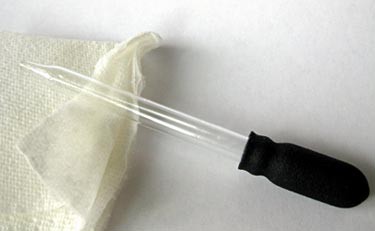 Image Credit: Teisha Rowland, Science Buddies / Science Buddies
Image Credit: Teisha Rowland, Science Buddies / Science Buddies
Figure 2. When you have sterilized a medicine dropper, prop it up somewhere, such as on the moist paper towel (folded on itself), to prevent its tip from touching anything.
- Open a fresh yogurt container.
- Using one of the sterilized droppers, mix the top part of the yogurt a little and then suck up a lot of yogurt, filling most of the dropper. Do not let the dropper's tip touch anything other than the yogurt
- One at a time, open the agar plates labeled 1, 2, and 3, and add two drops of yogurt to each plate. Add the drops into the center of the plates, one drop on top of the other. Close each plate before moving on to the next one. Do not add yougurt to plate 4.
- Use the second dropper to suck up distilled water. Add two drops of distilled water to the center of each plate, one drop on top of the other, just as you did with the yogurt. This time include plate 4. Plate 4 will be a control, to make sure that you are not growing bacteria from the distilled water.
- Use clean swabs to spread the yogurt and distilled water around the plates in zigzags. Use a new swab for each plate.
- Apply even pressure with the swab, trying not to puncture the agar.
- Evenly spread and distribute the yogurt and water drops, leaving no large clumps.
- Do not set the lids down on anything when you open the plates. Because of this you may want a helper to open the plates for you. If you have a helper do this, make sure they put disposable gloves on too.
- Prepare each plate one at a time. When you have finished with one plate, quickly put its lid back on. Try not to spend too much time on a plate, because leaving its lid open could cause bacteria that is not from the yogurt to grow on the plate.
- When you have finished spreading the yogurt on each plate, make sure to replace the lids on the plates and let them sit in the middle of the cutting board.
- Letting the plates sit for a few minutes will help the yogurt attach to the agar.
- Prepare the anaerobic chamber by lining the clean edge of the Pyrex bowl with a thick coil of Play-Doh®, as shown in Figure 3.
- You can stretch one coil out to cover more of the edge so long as each part of the edge has some Play-Doh. Try to distribute the Play-Doh evenly on the bowl's edge.
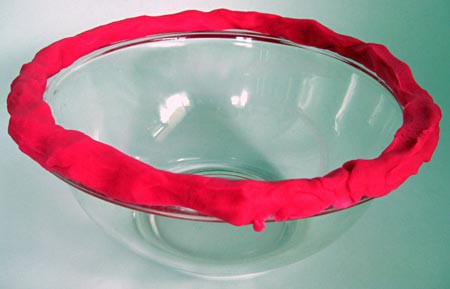 Image Credit: Teisha Rowland, Science Buddies / Science Buddies
Image Credit: Teisha Rowland, Science Buddies / Science Buddies
Figure 3. Thickly coil Play-Doh around the edges of the Pyrex bowl, as shown here.
- Stack the plates and flip them so that they are upside down (with the agar on the top of each plate).
- Arrange a tea light and the plates on the cutting board so that the bowl can cover them when it is upside down.
- The tea light can go on top of the stack of plates or to the side of them.
- Ask an adult to light the tea light.
- Put the bowl upside down on top of the plates and the lit tea light, as shown in Figure 4.
- Press down hard on the bowl so that the Play-Doh seals the bowl's edges on the cutting board.
- If the bowl is completely sealed, you have just created an anaerobic chamber. The tea light flame should consume any remaining oxygen inside of the sealed chamber. Once the oxygen is all gone, the flame will burn out, since fire needs oxygen to burn.
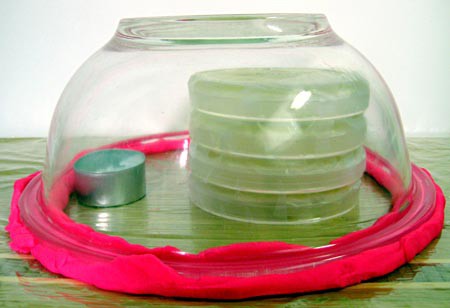
Figure 4. Stack the plates you prepared upside down on top of the cutting board, set the tea light candle next to the plates (the candle is on the left of the plates in this picture), light the tea light, and then flip the Pyrex bowl upside down on top of the plates and tea light. Press down hard on the bowl to seal the bowl's edges. The candle should go out (as it has here) within a minute.
- Watch the tea light. It should go out within about one minute of sealing the anaerobic chamber.
- If the tea light stays lit for more than two minutes, check to make sure that the anaerobic chamber is sealed. Add more Play-Doh around the edge of the bowl if needed.
- Leave the plates in a warm room, ideally between 22 to 27 degrees Celsius (about 72 to 80 degrees Fahrenheit), for six days.
- After the plates have been in the anaerobic chamber for two days, check the Play-Doh on the anaerobic chamber. If there are large cracks in the Play-Doh, as shown in Figure 5, carefully remove the Pyrex bowl and add fresh Play-Doh to seal the cracks.
- Ask an adult to help you re-light the candle and seal the bowl on top of the plates and candle again, pushing down hard on the bowl to seal it with the Play-Doh.
- Continue checking the anaerobic chamber daily to see if large cracks in the Play-Doh develop. If they do, repair them as described in part a of this step.
- After the plates have been in the anaerobic chamber for two days, check the Play-Doh on the anaerobic chamber. If there are large cracks in the Play-Doh, as shown in Figure 5, carefully remove the Pyrex bowl and add fresh Play-Doh to seal the cracks.
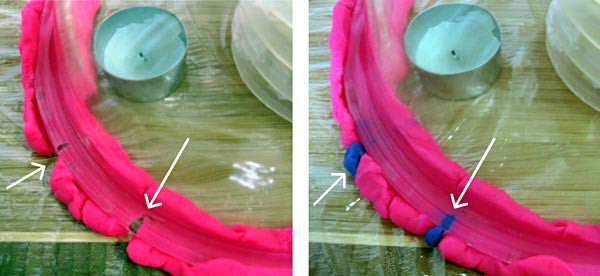 Image Credit: Teisha Rowland, Science Buddies / Science Buddies
Image Credit: Teisha Rowland, Science Buddies / Science Buddies
Figure 5. Check the anaerobic chamber after two days. If there are large cracks in the Play-Doh (as shown on the left, with the white arrows pointing to cracks), then carefully remove the Pyrex bowl and add fresh Play-Doh to seal the cracks, as shown on the right (using fresh blue Play-Doh, as the arrows point out).
- After the plates have been in the anaerobic chamber for six days, carefully remove the Pyrex bowl and take a look at the agar plates.
- In your lab notebook, make a data table like Table 2.
- Do you see anything on the plates, such as small spots, that could be bacteria colonies? If so, do some of the spots look different from others (in shape, texture, or color), possibly indicating that there are different types of bacteria colonies? Do some plates have more spots than others, or are all three plates similar? Write your answers and other observations in the data table in your lab notebook.
- Plate 4 should have had only distilled water on it, with no yogurt. Do you see anything on plate 4 that could be bacteria colonies? If so, does it look like this plate has more or fewer bacteria colonies than the plates with yogurt? What does this tell you? Record your observations. Hint: Re-read step 13c.
- Tip: If there is a lot of moisture on the inside of the lid making it difficult for you to see any potential bacteria colonies, you can hold the plate vertically (so it is not flat) and tap one end on a hard surface several times to make the moisture roll off of the lid.
- If you have a camera, take some pictures of your plates for your lab notebook or your Science Fair Project Display Boards.
- Putting the plates on a black background, such as a sheet of black construction paper, may help make your results more visible.
- What do your results tell you about whether yogurt has living organisms in it?
- If you are doing this experiment as a science fair project, repeat the procedure two more times. Scientists always repeat their experiments to make sure their findings are true and repeatable.
| Agar Plate | Are Bacteria Colonies Visible? | Are There Different Types of Bacteria Colonies? | Other Observations |
| #1 | |||
| #2 | |||
| #3 | |||
| #4 |
Bacterial Safety
Bacteria are all around us in our daily lives and the vast majority of them are not harmful. However, for maximum safety, all bacterial cultures should always be treated as potential hazards. This means that proper handling, cleanup, and disposal are necessary. Below are a few important safety reminders.
- Keep your nose and mouth away from tubes, pipettes, or other tools that come in contact with bacterial cultures, in order to avoid ingesting or inhaling any bacteria.
- Make sure to wash your hands thoroughly after handling bacteria.
- Proper Disposal of Bacterial Cultures
- Bacterial cultures, plates, and disposables that are used to manipulate the bacteria should be soaked in a 10% bleach solution (1 part bleach to 9 parts water) for 1–2 hours.
- Use caution when handling the bleach, as it can ruin your clothes if spilled, and any disinfectant can be harmful if splashed in your eyes.
- After bleach treatment is completed, these items can be placed in your normal household garbage.
- Cleaning Your Work Area
- At the end of your experiment, use a disinfectant, such as 70% ethanol, a 10% bleach solution, or a commercial antibacterial kitchen/bath cleaning solution, to thoroughly clean any surfaces you have used.
- Be aware of the possible hazards of disinfectants and use them carefully.
Ask an Expert
Global Connections
The United Nations Sustainable Development Goals (UNSDGs) are a blueprint to achieve a better and more sustainable future for all.
Variations
- If you saw bacteria colonies on your plates, could you identify the bacteria based on how the colonies look? This can be challenging to do, but by reading more about the species of bacteria in your yogurt and learning how to identify different colony morphologies (textures and shapes), you may be able to figure out what species of bacteria are growing on your plates. Tip: Read the experiment by Teresa Thiel that is listed in the Bibliography for details on two common bacteria species found from culturing yogurt and a description of what colonies of these bacteria look like. The Science Buddies guide to Interpreting Plates will also be helpful.
- How does temperature affect how the bacteria grow? Repeat this science project, but grow three plates at a colder temperature range and three plates at a warmer temperature range. Are there more bacteria colonies on plates grown at one temperature range compared to another? Why do you think this is?
- In this science project you created an anaerobic chamber to grow your bacteria. How well do you think the bacteria would grow in an environment with oxygen, an aerobic environment? Do this science project again but this time prepare three extra plates with yogurt and let them sit outside of the chamber, on the sterile cutting board, while the other three plates are inside of the anaerobic chamber. After letting the bacteria on the plates grow for six days, do you see a difference in the number of bacteria colonies inside the anaerobic chamber compared to outside?
- There are a lot of different types of yogurt available that list live cultures of bacteria on their packaging. Compare different brands of yogurt, such as some that list the same bacteria species or some that list different bacteria species. If two yogurts list the same bacteria species, does growing bacteria from those yogurts give you similar results? If yogurts list different bacteria species, do you get different results?
- Some yogurts do not say they have any bacteria inside of them. Find a brand of yogurt that does not list any bacteria species on its packaging and do this science project again, comparing this yogurt to one that does list bacteria species on its packaging. Do you see any bacteria colonies from the yogurt that does not list bacteria on its packaging? Or does it just result in a lot fewer bacteria colonies than the one that does list bacteria?
- Some other dairy products also advertise that they have live bacteria colonies. Look into what kind of diary products do this and repeat this science project using one of those products instead of yogurt. Are the bacteria in these other products also active?
- You can actually use yogurt to make more yogurt, by creating yogurt cultures. Create a yogurt culture using the yogurt you tested in this science project and then do the science project again on the yogurt culture you created. Does the yogurt culture give similar results to using the original yogurt? To learn how to create yogurt cultures, see this Science Buddies project:
- If you enjoyed trying to grow bacteria on agar plates in this science fair project, you may be interested in other Science Buddies projects that also involve growing microorganisms on agar plates. See:
Careers
If you like this project, you might enjoy exploring these related careers:
Contact Us
If you have purchased a kit for this project from Science Buddies, we are pleased to answer your questions.In your email, please follow these instructions:
- What is your Science Buddies kit order number?
- Please describe how you need help as thoroughly as possible:
Examples
Good Question I'm trying to do Experimental Procedure step #5, "Scrape the insulation from the wire. . ." How do I know when I've scraped enough?
Good Question I'm at Experimental Procedure step #7, "Move the magnet back and forth . . ." and the LED is not lighting up.
Bad Question I don't understand the instructions. Help!
Good Question I am purchasing my materials. Can I substitute a 1N34 diode for the 1N25 diode called for in the material list?
Bad Question Can I use a different part?
Contact Us


